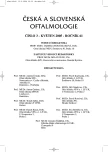Use of Ruthenuim 106 in Retinoblastoma Treatment
Authors:
P. Pochop 1; J. Mališ 2; B. Šímová 2; J. Malec 1; P. Palkosková 3
Authors‘ workplace:
Oční klinika dětí a dospělých, UK 2. LF a FN Motol, Praha
přednosta doc. MUDr. D. Dotřelová, CSc.
1; Klinika dětské onkologie a hematologie, UK 2. LF a FN Motol, Praha
přednosta prof. MUDr. J. Starý, DrSc.
2; Radioterapeuticko-onkologické odd. FN Motol, Praha
primář MUDr. J. Prausová
3
Published in:
Čes. a slov. Oftal., 61, 2005, No. 3, p. 192-197
Overview
The Charles University Teaching Hospital in Prague – Motol started to treat patients with retinoblastoma by means of brachytherapy after obtaining the permission to use closed source of ionizing radiation in the beginning of the year 2003. The applicator containing ruthenium (106Ru) emitting mostly the beta radiation was chosen. Half-life is 369 days and the nominal activity of the source is 21.1 MBq. The applicator is placed in place for one to several days according to the prominence of the tumor and actual activity of the source. Duration of the application is calculated with a special program. In the year 2003, three patients with retinoblastoma were treated. In one case bilateral involvement was determined, and the brachytherapy was used for treatment of both eyes. The next patient was treated twice; one treatment followed the other with different localization of the applicator because of too large basis of the tumor. In 2003, altogether the brachytherapy was used for treatment of retinoblastoma five times. In all cases, the combined treatment (chemo reduction, teletherapy, transpupillary thermotherapy, or cryotherapy) was performed. One eyeball was enucleated because of severe post-radiation retinopathy, the second one for persisting tractional retinal detachment. In remaining cases no serious complications or progression of the malignancy were observed.
Key words:
brachytherapy, retinoblastoma, ionizing radiation, radioisotope, ruthenium, closed source of ionizing radiation, ocular applicator
Labels
OphthalmologyArticle was published in
Czech and Slovak Ophthalmology

2005 Issue 3
Most read in this issue
- Terson’s Syndrome, Pars Plana Vitrectomy and Anatomical and Functional Outcome
- Congenital Stationary Night Blindness (CSNB) – a Case Report
- Spontaneous Late Subluxation of Capsule, Intraocular Lens and Capsular Ring in Patient with Pseudoexfoliation Syndrome – a Case Report
- Perforating Pars Plana Sclerotomy in Idiopathic Uveal Effusion Syndrome
